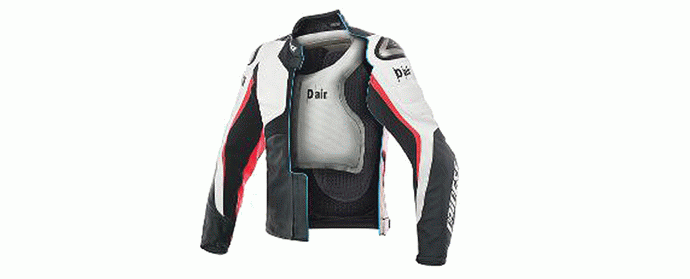Vulnerable road users on two wheels now have a choice of cutting-edge airbag technology to help prevent serious injury.
Following his 130 mph crash at this summer’s Ulster GP, professional rider and television personality Guy Martin praised the performance of his Dainese back protector. Now the same company is launching a new version of its standalone electronically deployed airbag motorcycle jacket airbag – technology that has already been deployed over 1000 on the track and road.

The new Misano 1000 leather jacket operates without need of sensor kit fitted to the motorcycle. The sensors, electronics and the GPS, in this configuration, are housed in the back protector.
The Dainese patented 3D airbag has an inner micro-filament structure which provides uniform inflation of 5cm over all surfaces to provide maximum protection and comfort.
six sensors housed in the back-protector monitor the dynamics of the rider’s body 800 times a second and determine when to deploy the system. Impacts, high-sides and low-slides with tumbling will all deploy the airbag. The £1,000 jacket will be available to buy from this autumn.
If you need great value motorbike Euro breakdown cover get an instant quote.
Airbags for bicycles
Everything about the Hövding airbag for cyclists is extraordinary: It cost £10m to develop; its sensors record the wearer’s movements 200 times a second and, with a price tag of £260, it costs more than many bicycles.
The ground-breaking approach to head protection for cyclists has resulted over 2,000 sales for Hövding, a significant proportion of which to cyclists in London. Airbags for bicycles go unnoticed because the design is indistinguishable from the collar on a winter coat. In the event of an impending collision, the airbag inflates in a tenth of a second.
When the Hövding was tested against 13 of the leading cycle helmets available to buy in Sweden in 2012, it proved to have more than three times better shock absorbency of all the other helmets. To be CE marked, a cycle helmet must reduce the force of acceleration at head impact to 250 g. The best performing conventional helmet managed 196 g – the Hövding achieved 65 g.
Given the safety benefits of cycle helmets are inconclusive and it has been shown that drivers are more inconsiderate towards cyclists who wear helmets, for those who choose to wear one the Hövding is worth consideration.
The ethical choice
The ETA was established in 1990 as an ethical provider of green, reliable travel services. Over 30 years on, we continue to offer cycle insurance , breakdown cover and mobility scooter insurance while putting concern for the environment at the heart of all we do.
The Good Shopping Guide judges us to be the UK’s most ethical provider.


0 Comments View now